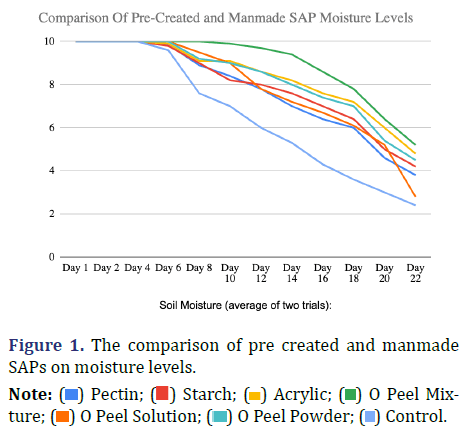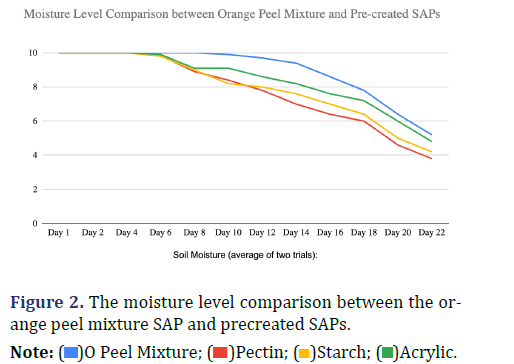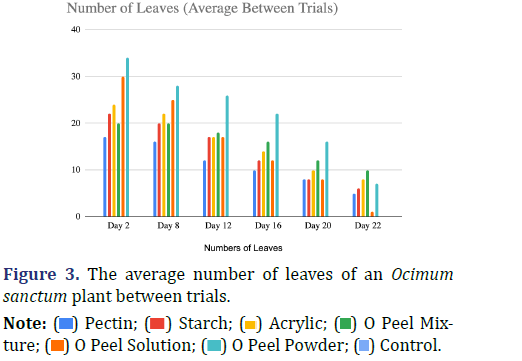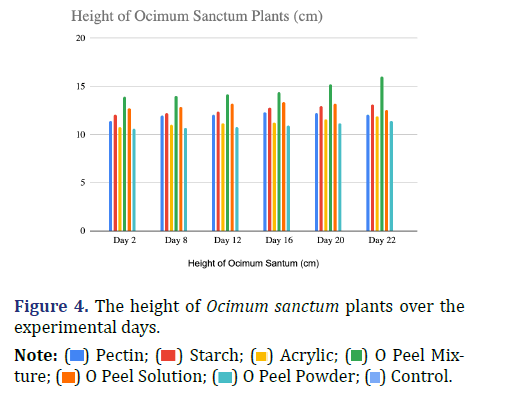Research - American Journal of Physiology, Biochemistry and Pharmacology (2024)
Creating an Inexpensive, Effective Super Saturated Polymer Out of Citrus Polysaccharides
Bray Tappotum*Bray Tappotum, Department of Biochemistry, Palos Verdes High School, California, USA, Email: brayrappotum1@gmail.com
Received: 11-Jan-2024, Manuscript No. AJPBP-24-124900 ; Editor assigned: 15-Jan-2024, Pre QC No. AJPBP-24-124900 (PQ); Reviewed: 30-Jan-2024, QC No. AJPBP-24-124900 ; Revised: 06-Feb-2024, Manuscript No. AJPBP-24-124900 (PQ); Published: 13-Feb-2024
Abstract
The loss of water when farming constructs a significant environmental issue, as droughts evaporate 30% to 75% of agriculturally used water. Retaining the water in the soil is an essential environmental act, as minimized water loss would occur, therefore acting against water depletion. The objective of this project was to create a cheap and yet effective super absorbent polymer from cross linked citrus polysaccharides, using both oranges and avocados.
I constructed a chemical system that allowed me to crosslink 17 oranges and 14 avocados through blending and a heating process of sitting in an oven for 180 degrees celsius for 20 minutes. Once the three built super absorbent polymers, and orange juice solution, an orange juice, orange peel, and avocado mixture, and an orange peel and avocado mixture were completed they were put into the soil boxes of 12 Ocimum sanctum plants along with prebuilt super absorbent polymers acrylic, pectin, and starch. For 22 days a soil moisture meter was used to take samples of moisture from each of the soil boxes and a ruler was used to measure the plant’s height. Once found, the moisture levels, height, and number of leaves of each plant were placed into a data table on a macbook air, completing the experimental procedure.
The combined mixture of orange peels, orange juice, and avocado peels stayed above a moisture level of 8 for 17 days and gained 2.03 cm of height proving that it was the most effective super absorbent polymer. This critical result was then achieved as only four leaves were lost for 16 days of testing.
Creating a cheap yet effective superabsorbent polymer from crosslink citrus polysaccharides proved to be an effective objective and may change the future of farming.
Keywords
Saturated polymers; Polysaccharides; Precipitation; Sterilize; Ventilation; SAP (Super Absorbent Polymer)
Introduction
A drought is a specific hydrologic impact causing water users from one location to experience low water supply. When rainfall and the amount of precipitation is at a decreasing amount, stream flows decline causing water amounts in lakes and rivers to gradually fall. If dry weather such as an increase in heat or evaporation occurs, and the precipitation levels continue at the low rate, the period may end up in a drought.
My birthplace, California, is no stranger to drought as it is a recurring feature in our dry and volatile climate, but around 420,000 people have been internally displaced by drought in Ethiopia (Drought, 1). This means that approximately 7.4 million of these peoples are food insecure, causing 4.7 million children to face and come to terms with acute malnutrition (Drought, 1).
When pondering about drought most people immediately think of water supply, as the significant and vivid image of lake water amounts dropping or even below ground water supplies decreasing create a sense of harm or surprise. But one of the most important and surprising effects of droughts is on crop yields and farming activities [1]. The world’s supply of water continues to make erratic and fluctuating changes, as it slowly decreases. Among that decrease, 3o% to 75% of agriculturally used water evaporates before being procured by the roots of greenery (Drought, 1). This means that precipitation levels in farming soil needed for a significant crop yield are being decreased as the high temperature and parched weather conditions evapotranspirate water, dehydrating crops causing death.
Within this industry, there are specific products known as super absorbent polymers, or SAPS. These polymers can act as hydrogens and quickly and efficiently store water when contact occurs (over 300 times its weight in liquid), allowing them to be placed in agricultural areas, causing the water to be retained until it reaches the roots of plants. These SAPS are primarily significantly expensive, costing up to 4,000 dollars. However, polymers are primarily made up of cross linked polysaccharides [2].
Orange peels contain over 63% polysaccharides, meaning that it shares a cohesive characteristic with SAPS, as polysaccharides allow the trapping of water molecules to occur, therefore creating an SAP. The monomers in orange peels are not reactive, but if I placed avocado peels into this experiment, the orange peels reactivity would become established, as evocados contain 54% natural oils. The natural oil would allow emulsion polymerization to take place, meaning the monomers could react into polymer chains forming the reactivity needed for SAPS.
SAPs found on market such as acrylic SAPS, starch SAPS, and pectin SAPS allow for an increase in positive water levels found in groundwater, however there are some generalities. Low polysaccharide numbers do not allow for maximum water retainability, and combined with increased prices due to severe California droughts, the SAPs have a low rate of work with a high rate of cost. Oranges are 1.49 dollars per pound while a pound of pectin SAP is 57.8 dollars, all while pectin based superabsorbent hydrogels combined with polyacrylonitrile were tested and were found to have an average rate of absorbance. The solution of creating a cheap, effective SAP out of polysaccharides will be found through a significant crosslinking method combined with numerous rounds of testing.
My overall objective is to create a cheap alternative to modern SAPS, by using a natural crosslinking method in orange peels. This would theoretically allow me to trap water molecules in the soil due to the citrus polysaccharides found in the samples.
Materials and Methods
Materials
Computer, latex gloves, plastic cover for table, 17 oranges, 100 ml of lemon juice, A water source, stove, pot, knife, 14 avocados, oven, strainer, napkins, pan, baking sheet, starch base, Acrylic acid (pH 1-2), Pectin base, Sodium Hydroxide, 10 same sized container (Preferred-237 mL), 20 kilograms of soils, 14 pots, 1 soil moisture meter, 12 Ocimum sanctum plants, Eye protection, Ventilation hood.
Methods (In numbered form for piecing together)
First three oranges will be peeled and the peels placed in 15 ml of lemon juice for 1 hour. The orange peels are placed in a pot filled with water (Around 100 ml). After, the peels are boiled for 45 minutes to 1 hour until liquid evaporation. Remove the peels from the pot and dry for excess liquid removal, allowing for an optimal SAP. Save the excess liquid as it will be used as variable “Orange Peel Solution” (60g of the liquid). After, cut up the peels into fine pieces allowing you to create an SAP powder in the end. Once completed skin 1 avocado. Cut up the avocados peel into extremely fine slices. Add the avocado skin to the orange skin and leave in the sunlight for 14 days. 90g of the dried orange and avocado skin has to be added to 80 ml of the stored orange liquid and once done place the mixture into an oven at 180 degrees celsius for 20 minutes. This allows for a drying process to be created creating a sample able to be grounded into a powder form. Take the mixture out of the oven and crush into fine powder. This is the variable “Orange Peel Powder ‘’ (60 g used as the variable while rest is stored). Add 40 grams of the powder to 20 grams of the sun dried avocado peel and orange peel mixture creating the variable “Orange Peel Mixture”. After, place the starch based, pectin based, and acrylic base SAPS into 6 separate containers (5 grams of each base with 200 ml of water). Also place the three orange variables into 6 separate containers (five grams of each variable including the orange ones are used). Leave the samples for 10 minutes creating a rest state. Fill 14 pots with 1 kg of soil. Mix each sample into separate pots so each pot has one variable (25 g of each variable). Leave two without variables, as they are the control groups. On the first day of testing water the soil with 100 mL of water. Every day for 22 days insert a moisture meter 4 cm deep into the plant at 6 different spots and average them out (Has to be at the same time each day; I had completed the testing at 7:00 A.M every day). When testing and calculating data use the formula: (Swollen sample weight-initial weight)/initial weight to calculate the water absorption). In the end follow the same steps but with Ocimum sanctum plants instead of plain topsoil (Measure soil moisture, number of flowers, and height in cm for 22 days).
Safety procedure
First place the eye protection over your eyes and place gloves and a lab coat on your hands and body. Then place a plastic covering over the table. After, handle the materials in a ventilation hood and when done place in a separate hazard bag and throw away. Then sterilize the space using paper towels and bacterial wipes.
Parental/Overlook procedure
Help the student with putting on the appropriate protection gear; gloves, eye protection, and a lab coat. Also assist the setup of variables and equipment in the experiment, all while monitoring the usage of chemicals. Your overall goal should be the mediating of the students experiment.
Results
The idea of creating a cheap superabsorbent polymer out of cross-linked citrus polysaccharides, that is more effective than pre-created superabsorbent polymers proved to be a challenge but the data proved my objective to be successful [3]. Throughout the experiment the acrylic superabsorbent polymer seemed to be the most effective pre-created SAP and the orange peel mixture seemed to be the most successfully created SAP so I will do a direct comparison between the two, proving my success.
From day 1 to day 22 the moisture levels of the Acrylic SAP ranged from 10 to 4.8 and dropped from 10 to 9 at day 10. However, for the orange peel mixture the moisture levels ranged from 10 to 5.2 dropping from 10 to 9 around day 15 (Figure 1).
During the experimental process the average amount of leaves (between the two trials) of the acrylic super absorbent polymer ranged from about 24 leaves on day 2 to about 8 leaves on day 22. This means that 16 leaves were lost for an average of 2 to 5 leaves lost per day of testing since day 1. However the orange peel mixture lost about 10 leaves from day 1 to day 22 averaging a loss of 2 to 4 leaves per day of testing since day 1, although for the first 8 days no leaves were lost, leaving the leaf remainder at a starting 20 [4,5].
Along with the testing of moisture levels and the average amount of leaves, the height of the Ocimum sanctum plants were also tested, showing the steady growth constant between each tested plant. On day 2 the plant with acrylic super absorbent polymer grew about 1.11 centimetres from 10.79 centimetres on day 2 to 11.9 centimetres on day 22. Although this showed steady growth, meaning the super absorbent polymer was successful the orange peel mixture also experienced change (Figure 2). Starting at 13.97 centimetres on day 2 and ending with 19 centimetres on day 22, the ocimum sanctum plant containing the orange peel mixture super absorbent polymer grew 2.03 centimetres within the testing time span [6] (Figures 3,4).
Discussion
A plant’s limited water supply might sustain them for up to 48 hours before the species starts to be affected by drought and hydration loss. The acrylic supersaturated polymers moisture levels dropped from 10 to 9 in 10 days meaning that enough water was retained in the soil for that amount of time to further nurture the ocimum sanctum before severe hydration loss, resulting in a loss of 16 leaves [7].
Although the data proves that the acrylic supersaturated polymer was successful, the orange peel’s moisture levels ranged from 10 to 5.2 dropping from 10 to 9 around day 15, meaning that even more water was retained in the soil further nurturing the ocimum sanctum for a longer period of time. This therefore resulted in a slower and lower loss of leaves, of 10 leaves from day 1 to day 22, averaging a loss of 2 to 4 leaves per day of testing since day 1, although for the first 8 days no leaves were lost, leaving the leaf remainder at a starting 20 [8].
Conclusion
Overall the retained moisture levels and lower loss of leaves with a higher increase of height therefore proves that the cheap alternative, the orange peel mixture, was proven to be the most effective supersaturated polymer, therefore successfully completing my objective.
A future study that can be conducted is the testing of other acidic, polysaccharide based items such as lemons and even some household chemicals. There might be an even more effective cheaper solution to the solution I have created, However, although more research can be done, the farming world might want to take up the idea of using orange peels as the polysaccharide base is not only healthy for the environment but is also more successful than the commercially available super saturated polymers.
When talking about my success I could have been slightly more detailed when it came to the testing time as I had been an hour off on specific days due to family travels.
References
- Ostrand MS, Desutter TM, Daigh AL, Limb RF, Steele DD. Superabsorbent polymer characteristics, properties, and applications. Agrosystems, Geosciences and Environment. 2020;3(1):e20074.
- Torrado AM, Cortés S, Salgado JM, Max B, Rodríguez N, Bibbins BP, et al. Citric acid production from orange peel wastes by solid-state fermentation. Braz J Microbiol 2011;42:394-409.
[Crossref] [Google Scholar] [Pubmed]
- Droughts: Facts, causes, and how we can help. Save the Children.
- The manufacturing process of super absorbent polymer.
- What Is SAP-Superabsorbent Polymers.
- Superabsorbent polymer.
- Drought. Department of Water Resources, California, 2022.
- Guilherme MR, Aouada FA, Fajardo AR, Martins AF, Paulino AT, Davi MF, et al. Superabsorbent hydrogels based on polysaccharides for application in agriculture as soil conditioner and nutrient carrier: A review. Eur Polym J 2015;72:365-385.














